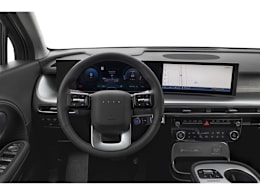Introduction
2026 Hyundai Ioniq 9 EV Has Powerful Motors and a Spacious InteriorBut the interior fit and finish doesn’t match the SUV’s price tag
Overview
We have completed testing of the Ioniq 9. Stay tuned for the full road-test report.
The 2026 Hyundai Ioniq 9 is a sleek, futuristic-looking three-row electric vehicle that shares its basic technology and design with the very similar Kia EV9 and other Genesis, Hyundai, and Kia EVs.
This midsized SUV arrives at a tumultuous time for EVs, with the auto industry dealing with the threat of tariffs, the elimination of federal tax incentives, and a shift to incorporating Tesla-style charge ports on their vehicles.
Amid that turmoil, Hyundai has gone full-throttle on EVs, with four fully electric models available in addition to a plethora of hybrids and plug-in hybrid electric vehicles. All told, the automaker has only three model lines that don’t have some form of electrification. Hyundai’s EVs share similar battery, charging, and motor designs, which are also used by models from Genesis, Hyundai’s luxury brand, and Kia, which is partially owned by Hyundai.
The number of all-electric three-row SUVs is rapidly increasing. Several competitors are already on the market or arriving shortly, including the Cadillac Vistiq, Kia EV9, Lucid Gravity, Rivian R1S, Tesla Model X, Volkswagen ID.Buzz, and Volvo EX90. More expensive options include the Cadillac Escalade iQ and Mercedes-Benz EQS SUV, while the Mercedes-Benz EQB is a smaller model with tiny third-row seats. In addition, the Genesis GV90 three-row EV is expected to debut later this year.
We based this first drive on a top-of-the-line Ioniq 9 Calligraphy we rented from Hyundai. We will be purchasing our own Ioniq 9 for our test program. We are buying a midlevel SEL, which is the trim that Hyundai expects to sell the most of. This first drive covers just the Calligraphy that has 422-hp, dual electric motors; 110.3-kWh battery; 1-speed direct drive; and AWD. Adding a few minor options, the total MSRP came to $77,320.
The final assembly point is Ellabell, Ga.


























